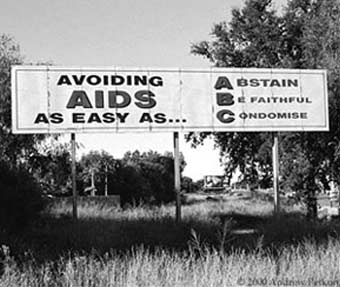|
|  |

|
| HIV/AIDS billboard promotion |
Ugandas National Response to the HIV/AIDS Surge
Evolution of the National Response
Like many other epidemics, Ugandas initial response to HIV/AIDS was principally confined to the health sector also. Most Ugandans thought of the disease as witchcraft and later a disease of the immoral which led to high levels of PHA (Persons with HIV/AIDS) stigmatization.
In 1986, surprised by many, Ugandas Health Minister announced the existence of HIV/AIDS during the World Health Assembly in Geneva. This admission marked the beginning of openness about the epidemic; albeit a message not welcomed by most African leaders. Thus paved the road for the commencement of mass campaigns throughout Uganda initiated by President Museveni.
The first structural AIDS control Programme in the Ministry of Health was established in 1986, since the Health sector had been the backbone of the countrys response. A year had past and it was only then that AIDS was recognized not only as a public health problem but also a problem affecting social and economic spheres of society. Consequently, the conception of the Multi-sectoral approach and the Uganda AIDS Commission (UAC), established in 1992, was initiated to eradicate the scourge of HIV/AIDS.
After Ugandas official admittance of the presence and tremendous effects caused by HIV/AIDS, political support and commitment marshaled remarkable support especially from the non-government, non-profit sector. By 1997, over 1200 agencies such as, government agencies, NGOs, UNAIDS, were implementing HIV/AIDS-related support in Uganda. UAC brings together these partners to review progress, identify gaps and set national priorities and strategies for implementation to ensure delivery and surveillance of HIV/AIDS progress.
Some key interventions and their progress include:
|
KEY INTERVENTIONS |
PROGRESS |
|
-(1986) STD/HIV/AIDS mass information and education campaigns; key messages are vulnerability, and prevention of transmission |
-Awareness rate 99.7%; knowledge 78%; positive change in behavior, including increased condom use, reduction in multiple-sex partners; also improvement in STD management |
|
-Personalizing the risk of HIV infection through voluntary counseling and testing; (1990) VCT (volunteer counseling and testing) services were pioneered |
-Almost half a million people have accessed VCT services;
-Government has embarked on national programmes to expand VCT to all districts and countries |
|
-Improving the quality of life of PHAs (people living with HIV/AIDS) has been a major initiative behind care and support services |
-Private, non-profit organizations (i.e., the AIDS Support Organization and faith-based organizations) have greatly contributed to the well-being of PHAs; on-going social and spiritual counseling, home-based care to relieve pressure of hospitals |
|
-Participation of UNAIDS pilot project on ARV (antiretroviral) facilitation; major hindrance: access and cost |
-National/global advocacy for price reductions of vaccines |
These and more interventions are largely supported by central efforts in the areas of advocacy, to aid in diminishing the disparate effects of the still growing HIV/AIDS epidemic in Uganda.
|
 |
|
Government Response
Ugandas government response to HIV/AIDS has been a collective effort by the government, NGOs, religious groups, individuals, and international donors. Ugandas openness, political support and commitment at the highest level of Government have characterized the national response to the epidemic. As well, there have been notable efforts to mobilize and unify response to the epidemic, at the international, national, district ad community levels, including the establishment of AIDS Control Programmes in Government ministries, NGOs and CBOs (Community Based Organizations).
In 1990/1991, President Yoweri Museveni adopted and subsequently adopted a multi-sectoral approach to the control of HIV/AIDS (MACA) in attempts to tame the epidemic. This approach highlights the notion of collective responsibility of individuals, community groups, different levels of government and other agencies for the prevention of HIV infection. The Strategic Framework for HIV/AIDS prevention and care for the 2000/1-2005/6 period was developed and organized under three broad goals:
-To reduce the rate of HIV infection;
-To mitigate the health and socio-economic impacts of HIV/AIDS
to community levels; and
-To strengthen the national capacity to respond to the epidemic.
|
 |
|
|  |
|
link to Uganda Red Cross Society
|
 |
|
|
|
|
The Multi-sectoral AIDS Control Approach to the Control of HIV/AIDS (MACA)
As HIV/AIDS continued to rapidly spread, but with much urgency, Uganda respond quickly. The Ministry of Health addressed the problem and initiated and co-coordinated various AIDS control activities, consequently leading to a higher level of awareness about the epidemic. However, because the coordination was being done by only the Health Sector, the epidemic continued to be addressed almost exclusively as a health problem. Realizing the impact of the HIV/AIDS epidemic went beyond the domain of health cutting across all aspects of individual, family, community and national life, the government therefore decided on an alternative approach towards AIDS control; the Multi-sectoral Approach.#
There are significant key features in the MACA that need to be emphasized.
FIRST: It advocates for the active involvement in AIDS Control activities by all members of society individually and collectively, with coordination at various administrative and political levels, including grassroot levels.
SECOND: The approach seeks to address not only HIV/AIDS prevention but also the active response to, and management of, all perceived consequences of the epidemic.
THIRD: The approach emphasizes organizational capacity-building for sustainable activities among sectors and individual organizations.
(Refer to Multi-sectoral page for a more detailed report)
|
|
|  |

